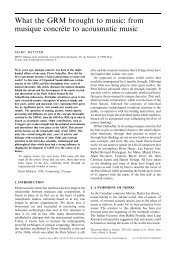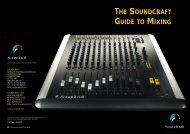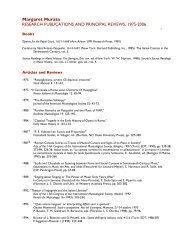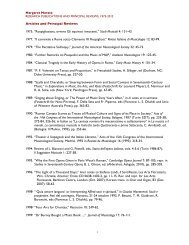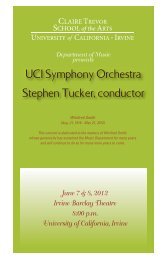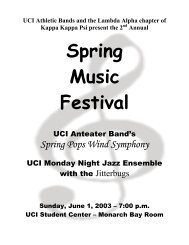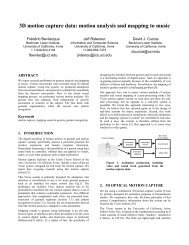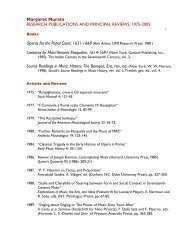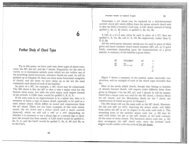âRoots and Branchesâ - Music - University of California, Irvine
âRoots and Branchesâ - Music - University of California, Irvine
âRoots and Branchesâ - Music - University of California, Irvine
Create successful ePaper yourself
Turn your PDF publications into a flip-book with our unique Google optimized e-Paper software.
Nationalist era (c. 1920 - 1940). During this period, he wrote his Afro-American Symphony, which is probably his best known work.. Still was born in 1895<br />
<strong>and</strong> died in 1978.<br />
Fredrick Tillis<br />
Frederick Tillis received a B.A. in 1949 from Wiley college in Marshall, Texas, an M.A. (1952) <strong>and</strong> Ph.D. (1963) from the <strong>University</strong> <strong>of</strong> Iowa in music<br />
composition. His teaching positions included: The <strong>University</strong> <strong>of</strong> Massachusetts, Kentucky State <strong>University</strong>, Grambling College, <strong>and</strong> Wiley College. Tillis<br />
developed an eclectic style using black music elements, African <strong>and</strong> Eastern idioms, serialism <strong>and</strong> other Europen styles. His works include: "Ring Shout<br />
Concerto," "Hallelujah," "Spiritual Cycle," "Freedom," "Designs for Orchestra," "<strong>Music</strong> for Alto Flute, Cello, <strong>and</strong> Piano," <strong>and</strong> "Quintet for Four Woodwinds<br />
<strong>and</strong> Percussion." He was a Danforth Associate (1969), United Negro College Fund Fellowship recipient, <strong>and</strong> recipient <strong>of</strong> a Rockefeller Foundation Grant<br />
(1978). His works are available from American Composer's Alliance.<br />
Richard Thompson<br />
Richard Thompson is a performer <strong>and</strong> composer whose work resists a single stylistic category. His compositions are in an eclectic third stream style,<br />
combining European formal structures with ideas which are essentially jazz in nature. Originally from Aberdeen, Scotl<strong>and</strong>, Mr. Thompson made his debut at<br />
the Purcell Room, in the Royal Festival Hall in London. Videmus Records released in 2006 a CD <strong>of</strong> Mr. Thompson’s work, entitled *Poetry Prelude*. The<br />
CD includes both song cycles*, The Shadow <strong>of</strong> Dawn *<strong>and</strong> *Dream Variation*s, performed respectively by Louise Toppin <strong>and</strong> Darryl Taylor. The recording<br />
also contains *Six Preludes for Solo Piano* <strong>and</strong> an arrangement for jazz quartet <strong>of</strong> the Spiritual*, Wade in the Water.* The CD is distributed by Albany<br />
Records. In 2008 Arabesque Records released Swing Low, Sweet Chariot. This CD contains eight <strong>of</strong> Mr. Thompson’s jazz arrangements <strong>of</strong> well-known<br />
spirituals. Mr. Thompson is currently Associate Pr<strong>of</strong>essor <strong>of</strong> <strong>Music</strong> at San Diego State <strong>University</strong> where he teaches jazz history <strong>and</strong> performance, <strong>and</strong><br />
classical theory. Mr. Thompson is preparing his chamber opera, entitled *The Mask in the Mirror*, for performance. The subject matter is the courtship <strong>and</strong><br />
marriage <strong>of</strong> Paul Laurence Dunbar to Alice Ruth Moore. Richard Thompson earned his undergraduate degree in music from the <strong>University</strong> <strong>of</strong> Edinburgh,<br />
Scotl<strong>and</strong>. His Masters Degree is from Rutgers <strong>University</strong> in New Jersey. He also holds a jazz diploma from The Berklee College <strong>of</strong> <strong>Music</strong> in Boston.<br />
Thomas G. Wiggins “Blind Tom”<br />
Thomas Greene Wiggins was born on the Wiley Edward Jones plantation in Harris County, Georgia on May 25, 1849. He came into the world blind <strong>and</strong><br />
autistic but a musical genius with a phenomenal memory. Even after Emancipation, his former owners kept him, in the words <strong>of</strong> the late author Geneva<br />
H<strong>and</strong>y Southall, "Continually Enslaved". His many concerts <strong>and</strong> the sale <strong>of</strong> his sheet music earned fabulous sums <strong>of</strong> money. Nearly all <strong>of</strong> it went to his<br />
owners <strong>and</strong> their heirs. Mary Bethune became his piano teacher. Because she had studied with Pr<strong>of</strong>essor George W. Chase, the highly respected New Yorktrained<br />
pianist- composer-conductor, one can assume that Tom received a solid theoretical <strong>and</strong> technical musical foundation. Soon after, his love <strong>of</strong> music<br />
<strong>and</strong> music-making led him to write original songs <strong>and</strong> imitate sounds <strong>of</strong> nature <strong>and</strong> other musical instruments on the piano. Before he was six years old,<br />
Tom was being shown <strong>of</strong>f to the Bethune family's neighbors. In October 1857, General Bethune rented a concert hall in Columbus <strong>and</strong> for the first time<br />
"Blind Tom" performed before a large audience that had difficulty comprehending how a blind idiotic slave child could master the piano keyboard. One <strong>of</strong><br />
the earliest concert reviews published in the Baltimore Sun on June 27, 1860 announced to its readers that Tom was a phenomenon in the musical world--<br />
"thrusting all our conceptions <strong>of</strong> the science to the wall <strong>and</strong> informing us that there is a musical world <strong>of</strong> which we know nothing." A comm<strong>and</strong> performance<br />
before President Buchanan at the White House drew further attention <strong>and</strong> the press referred to him as the greatest pianist <strong>of</strong> the age whose skills surpassed<br />
Mozart. The Bethune family was estimated to had made over $750,000 from Tom’s musical skills. After many legal proceedings over custody <strong>of</strong> Tom, he<br />
ended up in the care <strong>of</strong> Eliza Stutzbach for the remainder <strong>of</strong> his life while he performed until four years up to his death in 1908.<br />
What Is Art Song?<br />
Usually a short composition for solo voice with piano accompaniment, based on a poetic text <strong>and</strong> composed in a fairly simple style<br />
designed to enhance the significance <strong>of</strong> the text. The lied (art song)- differing from the folk (or popular) song, which is usually<br />
unaccompanied, anonymously composed, <strong>and</strong> transmitted by oral tradition- is the personal creation <strong>of</strong> an individual composer aiming at<br />
artistic perfection. In its deceptive simplicity, the lied conceals the artfulness with which its creator fused the three elements <strong>of</strong> text,<br />
melody, <strong>and</strong> accompaniment into a unified whole.<br />
Pr<strong>of</strong>usion <strong>of</strong> lyrical poetry in Europe at the end <strong>of</strong> the eighteenth century led to the flourishing <strong>of</strong> the lied. It requires greater freedom <strong>of</strong><br />
expression <strong>and</strong> a need to reflect ones intimate sentiments in compositions that blend words <strong>and</strong> music. Another important contributing<br />
factor to lied's development was the growth <strong>of</strong> the middle class in which the women, instead <strong>of</strong> working, spent their time in pursuit <strong>of</strong><br />
cultural activities, i.e., learning to play the piano (at that time found increasingly in private residences), singing, <strong>and</strong> buying the increased<br />
quantities <strong>of</strong> music distributed by the new commercial entrepreneurs, the music publishers.<br />
In its most current forms, art song ranges from short <strong>and</strong> simple to rhapsodic. A song cycle can last an entire evening, or be as brief as five<br />
minutes. Freedom <strong>of</strong> expression is a key element to the definition <strong>of</strong> art song. And collaboration; not only must the singer present the<br />
melody <strong>of</strong> any given composer, but the responsibility for setting the mood <strong>of</strong> the poem, commenting on the action, elaborating the<br />
vocalist's line through the anticipation or echo <strong>of</strong> a phrase, providing an interlude between stanzas, or concluding the song with an<br />
instrumental postlude rests with the accompaniment. Through the years, the significance <strong>of</strong> the piano accompaniment presented a problem<br />
to composers <strong>and</strong> critics concerned with the relative importance <strong>of</strong> words <strong>and</strong> music in the lied. Earlier writers indicated the interpretation<br />
<strong>of</strong> the text as the duty <strong>of</strong> the singer. By the late eighteenth century, however, the piano accompaniments began to share in the support <strong>of</strong> the<br />
vocal melody, sometimes through increased harmonic activities, other times through enrichment <strong>of</strong> the texture or embellishment <strong>of</strong> the<br />
melodic line.<br />
Source: Brody, Elaine <strong>and</strong> Fowkes, Robert. The German Lied <strong>and</strong> its Poetry. New York: New York <strong>University</strong> Press, 1971.



